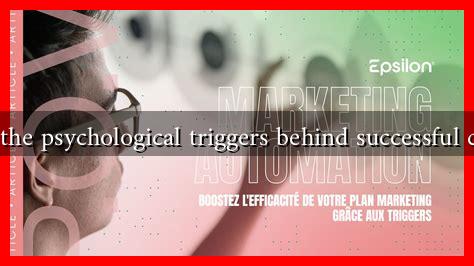-
Table of Contents
What are the Psychological Triggers Behind Successful Campaigns?
In the world of marketing, understanding the psychological triggers that drive consumer behavior is crucial for creating successful campaigns. These triggers tap into the emotions, motivations, and cognitive biases of individuals, influencing their decisions and actions. This article explores the key psychological triggers that underpin successful marketing campaigns, supported by examples and case studies.
The Power of Emotion
Emotions play a significant role in decision-making. Campaigns that evoke strong emotional responses tend to be more memorable and effective. According to a study by the American Marketing Association, emotionally charged advertisements can increase engagement and brand loyalty.
- Fear: Campaigns that highlight potential risks or negative outcomes can motivate consumers to take action. For instance, anti-smoking ads often use graphic imagery to evoke fear and discourage smoking.
- Happiness: Positive emotions can create a favorable association with a brand. Coca-Cola’s “Share a Coke” campaign, which personalized bottles with names, generated joy and connection among consumers.
- Sadness: While it may seem counterintuitive, sadness can also be a powerful motivator. The ASPCA’s commercials featuring sad animals have raised millions in donations by appealing to viewers’ compassion.
Social Proof and Authority
Humans are inherently social beings, often looking to others for cues on how to behave. This phenomenon is known as social proof. Successful campaigns leverage this by showcasing testimonials, reviews, and endorsements from credible figures.
- Testimonials: Brands like Airbnb use customer reviews to build trust and credibility. When potential customers see positive feedback from others, they are more likely to make a booking.
- Influencer Marketing: Collaborating with influencers can enhance a brand’s authority. For example, beauty brands often partner with popular makeup artists to promote their products, leveraging their expertise and follower trust.
The Scarcity Principle
The scarcity principle suggests that people place a higher value on items that are perceived as limited or exclusive. This psychological trigger can create urgency and prompt consumers to act quickly.
- Limited-Time Offers: Retailers like Amazon frequently use flash sales to create a sense of urgency, encouraging consumers to make impulsive purchases.
- Exclusive Products: Brands like Supreme thrive on scarcity by releasing limited-edition items, driving demand and increasing brand desirability.
Reciprocity and Commitment
The principle of reciprocity suggests that when someone does something for us, we feel compelled to return the favor. Successful campaigns often incorporate this principle to foster customer loyalty.
- Free Samples: Companies like Costco offer free samples to entice customers. Once consumers experience a product, they are more likely to purchase it out of a sense of obligation.
- Commitment Devices: Brands like Weight Watchers encourage commitment by having users set goals and share them publicly, increasing the likelihood of follow-through.
Case Studies: Successful Campaigns in Action
Several brands have effectively utilized these psychological triggers in their campaigns:
- Always – #LikeAGirl: This campaign challenged gender stereotypes and empowered women, evoking strong emotions and sparking conversations about self-esteem.
- Dove – Real Beauty: Dove’s campaign celebrated diverse body types and challenged conventional beauty standards, creating a strong emotional connection with consumers.
Conclusion
Understanding the psychological triggers behind successful campaigns is essential for marketers aiming to connect with their audience effectively. By leveraging emotions, social proof, scarcity, and reciprocity, brands can create compelling narratives that resonate with consumers. As demonstrated by various case studies, these psychological principles not only enhance engagement but also foster brand loyalty and drive sales. In an increasingly competitive market, harnessing these triggers can be the key to a campaign’s success.

